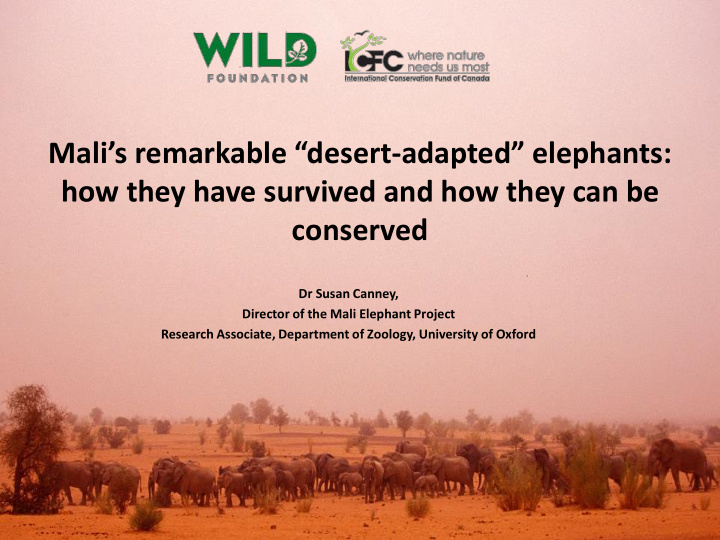



Mali’s remarkable “desert - adapted” elephants: how they have survived and how they can be conserved Dr Susan Canney, Director of the Mali Elephant Project Research Associate, Department of Zoology, University of Oxford
Range of habitats
How have these elephants survived? • Internationally important elephant population • 12% of all West African elephants • Most northerly in Africa • Undertake the longest & most unusual circular migration of all elephants • One of two populations of desert elephants
Timbuktu 100km
Timbuktu 100km
Zoom in to Banzena
Photograph by Carlton Ward Jr
Photograph by Carlton Ward Jr
Timbuktu 100km
Hamniganda
Lake Gossi
Conclusions 2006 • Urgent action required at Banzena and the Porte des Elephants • Incremental degradation & increasing human activity all over the elephant range and beyond perception of increasing elephant numbers. We had 5 years to start turning things around
But what to do? In 2006: - 2 foresters posts for an area the size of Switzerland & no vehicles - No resources - No government morale or political will
Community dialogue : understanding the human dimension “If elephants disappear it means the environment is no longer good for us”
Attitude survey 2009 351 people
Building a shared vision within Mali STAKE ST AKEHOLDERS DERS OUTREA TREACH CH & E & ENGAGEM EMEN ENT Educati tion, Training raining, Info Informati rmation GOVERNMENT, TOURISTS, DONOR, NGO VISITORS STRA ST RATE TEGIES IES & & PROJECTS ACTION CTIONS SENSITIVE PLANS, STRATEGIES, ECO-TOURISM POLICIES THREA TH REATS TS OCCUPIED ELEPHANT ROUTE Competition Impaired access for resources to resources LOCAL COMMUNITY ACTION LOCAL COMMUNITIES GRASS- SCHOOLS COMMUNITY ROOTS LEADERS
Outreach
10s of 1,000s
Over 96%
High degree of resource exploitation by outsiders High levels of degradation • Shifting ‘bush cultivation ’ erosion
Over 50%
Based on study results - brought together clans, ethnicities, local government together to agree on the problems, thus establishing common ground Then work out solutions that bring benefits for elephants, people & the ecosystem
“Since we left we no longer have stomach aches. The men can go back to Banzena if they want but we are staying here”
Biggest problem is no commonly agreed NRM systems across ethnicities
Community NRM that includes elephant habitat protection: management committee plus patrols
Management committee designated 40,000 ha pastoral reserve 92,380 ha by adjacent communities
Legal back-up • Decentralization legislation: – Local & intercommunal conventions • Livestock legislation (Charte pastorale): – Establishment of pasture reserves • Communities legislation: – Establishment of community groups and “associations” with authority to act as foresters • Planning legislation – Area zonation • Environmental legislation – Species protected from over- exploitation and hunting
Firebreak economics: • Pasture at the end of the dry season & no need to buy forage at a premium • Sale of hay • Sale of grazing access rights Livestock worth 50% more, healthier, give more milk and produce more young One community made $24,000 per year divided between the management committee, the eco-guards and the women
Guiding vision Model of human-nature co-existence : – ecosystem restoration through community empowerment supported by government – reintroduction of lost species
2011 – fall of Gadaafi, return of Tuareg mercenaries and re- ignition of rebellion
Intercommunity meeting – 4 days
Grain distribution
Elders & clan leaders Pledged to convey the message throughout the community and to the leaders of the armed groups ….. “Anyone who kills elephants steals from the local people” Traditional chief of Ebanguimallen
Vigilance networks providing an occupation with status and preventing radicalisation They have information but not armed enforcement back-up
The eco-guards are central
Creating an anti-poaching unit
Building and maintaining community solidarity Community benefits from collective resource management that leaves space and resources for people and elephants
Thank you! www.wild.org/mali-elephants
Recommend
More recommend